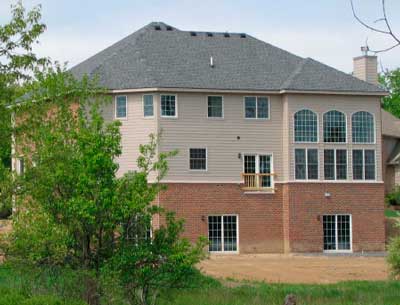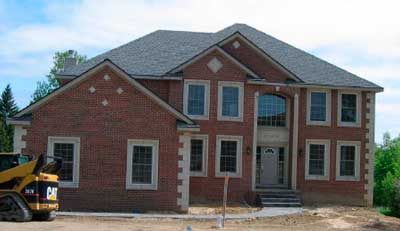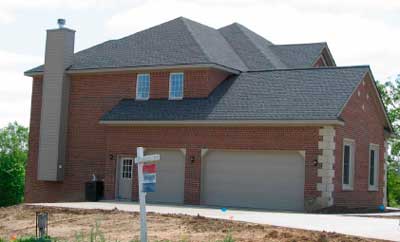Roofer Dies From Fall Off Residential Roof
Michigan Case Report: 07MI172
Summary
On August 11, 2007, a 34-year-old male self-employed roofer fell from the unprotected roof edge of a residential home under construction. A friend of the decedent, who was also a roofing contractor, had hired him. There were four to six members on the work crew. The sequence of events leading to the fall is unknown. The decedent was not wearing or using personal fall protection equipment. When his coworkers discovered he had fallen, they called for emergency response. Emergency response arrived, and he was taken by helicopter to a nearby hospital. The decedent died five days later of medical complications from the injuries sustained at the time of the fall.

|
|
Figure 1. View of rear of residence under construction |
Recommendations:
- Roofers and employers conducting work activities on a roof should utilize fall protection measures when required.
- The controlling/managing construction firm should monitor the work activities for safety of those working for them regardless of the contract arrangements.
Introduction
On August 11, 2007, a 34-year-old male roofer fell from the unprotected roof edge of a residential home which was under construction. MIFACE was notified of this incident when the individual’s death certificate was received. On May 27, 2008, MIFACE spoke with the decedent’s sister about the fall. She stated that she had been in contact with the decedent’s friend, the roofing contractor, after her brother’s death. After the MIFACE interview, MIFACE contacted the decedent’s sister and asked if she would contact the roofing contractor on behalf of MIFACE to ask if the roofing contractor would be willing to talk with MIFACE about the incident site and the roofing crew’s activities at the incident site. The roofing contractor did not contact MIFACE. There was no police response to the incident. MIFACE contacted the responding fire department’s emergency response personnel on several occasions to gather information about the incident scene. The fire department personnel would not provide any information about the circumstances of the fall, such as the roof location (back, front or side roof) from which the decedent had fallen and the surface to which he fell. During the course of writing this report, the death certificate was reviewed. There was no autopsy. The MIFACE researcher took the pictures used in this report after meeting with the decedent’s sister and removed identifying residence information from the pictures.
The decedent’s sister indicated that the decedent had performed roofing activities for at least 13 years. He had worked for approximately eight years as an employee of a roofing company. For the past five to six years, he had his own roofing business. The individual who contacted the decedent was a friend who owned a roofing company. The decedent had known this individual for many years and had worked for him as an independent contractor on many occasions.
The decedent, according to his sister, was “out late” at a “bar” the night before the incident. On the day of the incident, the decedent’s employer picked up the decedent at his sister’s home between 6:30 a.m. to 7:00 a.m. and proceeded to the work site.
MIOSHA Construction Safety and Health Division did not conduct a fatality investigation because the individual was self-employed.
Investigation
The decedent’s sister believed that the work began at 7:00 a.m. that morning. The crew had been working for approximately two hours when the incident occurred. She was unsure of the exact number of individuals in the roofing crew; she believed that there were four to six individuals at the site. The crew had been at the house for less than one week performing roofing activities. His sister thought that the decedent would be wearing his tool belt while performing any activity on the roof. She did not know what roofing activities were being conducted at the time of the fall. According to his sister, the decedent’s fall was unwitnessed.
His sister stated that the decedent fell from the roof at the back of the house. The decedent’s employer was on the “other side of the roof.” The decedent fell three stories and landed on packed dirt. MIFACE cannot confirm this statement because neither the decedent’s employer nor the fire department emergency response personnel responded to MIFACE inquiries. (See Figures 1, 2, and 3)
 |
|
Figure 2. Front view of home under construction |
It is unknown if the employer had fall protection equipment on site or if a fall protection plan was in place. The decedent was not using fall protection equipment. After his coworkers discovered the decedent had fallen from the roof, someone called for emergency response. Emergency response arrived, and the decedent was transported by helicopter to a nearby hospital. He died five days later from injuries sustained at the time of the fall.
 |
|
Figure 3. Side view of home under construction |
Back to Top
Cause of Death
The cause of death as stated on the death certificate was multiple trauma. The death certificate stated that Other Significant Conditions contributing to the death but not resulting in the underlying cause was drug and alcohol abuse. An autopsy was not performed.
Back to Top
Recommendations/Discussion
Roofers and employers conducting work activities on a roof should utilize fall protection measures when required.
According to the national Bureau of Labor Statistics Census of Fatal Occupational Injury (CFOI) data in 2007, falls from roofs accounted for 19% of all fatal falls. In the construction industry, roofers accounted for 6% of all work-related fatalities. In Michigan, falls accounted for 47 (21 percent) of the more than 200 workplace fatalities investigated by MIOSHA in the past five years. According to the Michigan CFOI data, eight individuals died as a result of a fall from or through a roof in Michigan in 2006. (Michigan CFOI data regarding fatal falls for 2007 was not available at the time of writing this report).
In Michigan, there were 875 work-related deaths for the six years of 2001-2006. One hundred twenty five (14.3%) of the deaths were a result of a fall. The other major industrial sectors for fatal falls besides construction were manufacturing with 9% and agriculture with 7% of the deaths. Roofers and Roofer Helpers were the occupational group in Construction most likely to experience a fatal fall (20 of 75), followed by Carpenters (9 falls), and Painters and Construction Laborers (7 falls each).
The MIOSHA Construction Safety and Health Division issued Residential Fall Protection Compliance Criteria (COM 04-1) on June 25, 2004. The intent of this instruction was to establish clear and concise interpretation and guidelines for compliance with MIOSHA Part 45, Fall Protection, 1926.500 through 1926.503 as adopted by Michigan R 408.44502. This and other MIOSHA Policies and Procedures are accessible from the MIOSHA websiteexternal icon at: http://www.dleg.state.mi.us/dms/results-miosha.asp?doccat1=Instruction&docowner=MIOSHA&doctitle=&orderby=DOC_DATE
For residential construction activities, there is an exception to the requirement to have conventional fall protection or to adopt alternative fall protection measures under 1926.501(b). This exception allows the residential construction employer to develop a Fall Protection Plan that meets the requirements of 1926.502(k) when an employer can demonstrate that it is infeasible or creates a greater hazard to use conventional fall protection or alternative fall protection measures. MIOSHA presumes that the implementation of at least one of the above-listed fall protection systems is feasible and will not create a greater hazard when implemented. Infeasibility would only apply in rare, unusual circumstances.
Thus, the residential construction employer has the burden of establishing that the implementation of conventional fall protection or alternative fall protection measures are infeasible or create a greater hazard and that it is appropriate to implement a Fall Protection Plan, which complies with 1926.502(k) for a particular workplace situation.
Certain types of residential construction are exempt from having to show infeasibility or a greater hazard in order to use a Fall Protection Plan. These groups (1, 2, 3, and 4) must have an Alternative Fall Protection Plan but the Plan does not have to be written nor does it have to be specific to the job site. Group 1 consists of those employers who install floor joists, floor sheathing and roof sheathing; erect exterior walls, or set and brace roof trusses and rafters. Group 2 employers would include those who work on concrete and block foundation walls and related formwork.
The decedent’s employer most likely was performing work in either Group 3 or Group 4. Group 3 consists of the following activities when performed in attics and on roofs: installing drywall, insulation, HVAC systems, electrical systems, plumbing and carpentry. Group 4 includes roofing work, such as the removal, repair or installation of weatherproofing roofing materials such as shingles, tile and tar paper.
The MIOSHA Instruction identifies a restriction as to whether alternative fall protection measures may be used on a residential construction site for Group 4, Roofing Work. The Alternative Fall Protection Plan (AFPP) outlined in the Instruction may only be used for this work where: (a) the roof slope is 8 in 12 or less, and (b) the fall distance, measured from the eave to the ground level is 25 feet or less. There are 10 criteria MIOSHA mandates be a part of the AFPP if both the roof slope and fall distance requirements are met.
In this incident, the decedent’s employer could not use the exception and develop an alternative fall protection plan for the work site. The roof slopes were at 8 in12 or less, but the roof due to roof heights would not satisfy the fall distance requirement of 25 feet or less. Conventional fall protection (guardrail, safety net systems or personal fall arrest systems) or alternative fall protection measures (other measures described under 1926.501(b) that could be used instead of conventional fall protection) or a catch platform (a scaffold built at the edge with a guard rail) were required while the roofing crew was on the roof.
Self-employed roofers and employers conducting work activities on a roof should ensure that adequate fall protection means are used. At some time during the sheathing process, the roof becomes stable enough and conventional fall protection systems are to be used. Once the first couple courses of sheathing go on, the system can be anchored at the roof peak and workers can move horizontally, moving their anchor point with them. MIFACE conducted an Internet search and found many providers of personal fall arrest systems that included the anchorage connector, body wear and connecting device, many were less than $150.00.
The controlling/managing construction firm should monitor the work activities for safety of those working for them regardless of the contract arrangements.
Controlling/managing construction firms have, in addition to an ethical responsibility, a MIOSHA mandated responsibility, to monitor the work activities for safety of those working for them regardless of the contract arrangements. For this incident, the new home’s construction manager would have had the controlling contractor responsibilities. It is unknown whether this firm employing the construction manager had specific contract right to control safety on the construction site. Even if the firm/construction manager did not have this authority, MIOSHA would designate the firm/construction manager as the controlling employer. The ability of the construction manager to control safety in this circumstance would have resulted from a combination of contractual rights that, together, gave it broad responsibility at the site involving almost all aspects of the job. Its responsibility was broad enough so that its contractual authority necessarily involved safety. MIOSHA considers the authority to resolve disputes between subcontractors, set schedules and determine construction sequencing is considered particularly significant because they are likely to affect safety.
References
MIOSHA standardsexternal icon cited in this report may be found at and downloaded from the MIOSHA, Michigan Department of Labor and Economic Growth (DLEG) website at: www.michigan.gov/mioshastandards. MIOSHA standards are available for a fee by writing to: Michigan Department of Labor and Economic Growth, MIOSHA Standards Section, P.O. Box 30643, Lansing, Michigan 48909-8143 or calling (517) 322-1845.
- MIOSHA Construction Safety and Health Standard, Part 45, Fall Protection.
- MIOSHA Construction Safety and Health Division, Residential Fall Protection Compliance Criteriaexternal icon (COM 04-1). http://www.dleg.state.mi.us/dms/resultsmiosha. asp?doccat1=Instruction&docowner=MIOSHA&doctitle=&orderby=DOC_DATE
- MIOSHA Agency Instruction: Multi-Employer Work Sitesword iconexternal icon. Document Identifier – MIOSHA-COM-04-1R2. Date: July 31, 2007. http://www.dleg.state.mi.us/wsh/docs/inst/miosha_com_04_1r2.doc
- A 16-year-old Died After Falling 27 Feet at a Residential Construction Site – Alabama NIOSH In-House FACE Report 2000-16. https://www.cdc.gov/niosh/face/In-house/full200016.html
- MIOSHA Tell Employers “The Falls Must Stop!” MIOSHA Launches Campaign to Reduce or Eliminate Accidents Caused by Falls.pdf iconexternal icon Release Date: March 10, 2008. http://www.mcim.com/docs/MIOSHA_-_The_Falls_Must_Stop.pdf
- Bureau of Labor Statistics, Injuries, Illness and Fatalities (IIF), Fatal Occupational Injuries – Michigan. external iconhttp://www.bls.gov/iif/oshwc/cfoi/tgs/2006/iiffi26.htm
- Census of Fatal Occupational Injuries, 2007external icon. Bureau of Labor Statistics (National). http://www.bls.gov/iif/oshcfoi1.htm#charts
Michigan FACE Program
MIFACE (Michigan Fatality Assessment and Control Evaluation), Michigan State University (MSU) Occupational & Environmental Medicineexternal icon, 117 West Fee Hall, East Lansing, Michigan 48824-1315; http://www.oem.msu.edu. This information is for educational purposes only. This MIFACE report becomes public property upon publication and may be printed verbatim with credit to MSU. Reprinting cannot be used to endorse or advertise a commercial product or company. All rights reserved. MSU is an affirmative-action, equal opportunity employer. 9/22/08
MIFACE Investigation Report # 07MI172 Evaluationpdf iconexternal icon (see page 7 of report)
